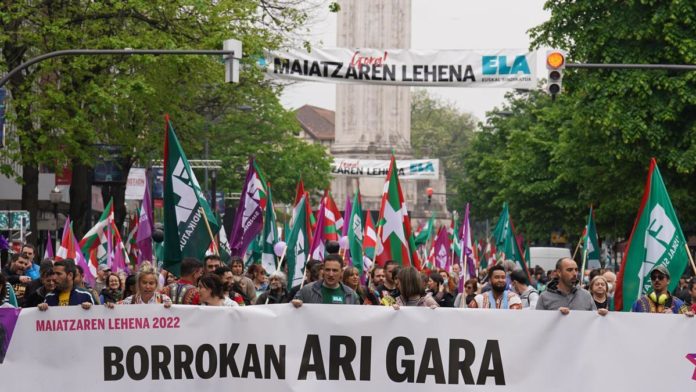Various agencies play an important role in a process of national liberation: political parties, popular movements, cultural agents and, of course, trade unions. It is difficult to imagine a process of national liberation without the strength of the trade unions. And this is so because in the Basque Country, and among other stateless peoples of Europe, the unions have more members than the political parties.
How strong are the nationalist and pro-independence trade unions in the various stateless nations of Europe? We know quite well the importance of the nationalist political parties in those nations, also their names, as well as their representation in the local parliaments, but the same does not happen with the trade unions. Our association Naziogintza has carried out a research project on nationalist and pro-independence trade unionism in Europe, and in this article we summarize our conclusions.
BASQUE COUNTRY:
Basque nationalism was articulated as a political movement at the end of the 19th century. At that time, the first socialist and Spanish trade unions also appeared in our country. As a counterpoint, in 1911 Basque nationalism created the first patriotic union, ELA (Eusko Langileen Elkartasuna, i.e., Solidarity of Basque Workers). Within a few years, ELA became the hegemonic trade union in the Basque Country, maintaining this hegemony to this day, with more than 100,000 members in a country of only 3 million inhabitants.
In 1974 the other nationalist union of the Basque Country, LAB (Langile Abertzaleen Batzordeak, i.e., Patriot Worker Committees) was created. LAB is at this time the second most important union in our country, with some 50,000 members.
In the Basque Country under Spanish rule, ELA has 36% of union representation, and LAB has 19%. Basque nationalist trade unionism is therefore hegemonic in this part of our country. On the other hand, the Spanish unions (CCOO + UGT) have only 35% of union representation. LAB also has a presence in the Northern Basque Country, under French rule.
The collaboration between the Basque nationalist trade unions is essential to launch an independence process in our country. In 1998, ELA and LAB worked together, with other political agencies as well, in the so-called Lizarra-Garazi process, in which great advances were made in the national field to overcome the current political framework of Spanish domination. Unfortunately, the 1998 sovereignty process came to an abrupt end in 2000, when the armed organization ETA ended the truce it had begun two years earlier.
Today, unfortunately, there is no pro-independence process in our country, and the relations between ELA and LAB are not good. We firmly believe that only by putting aside differences and reaching a minimum national agreement will it be possible to set in motion a new process of national liberation in the Basque Country. There are in our country solid trade union and political majorities in favor of self-determination, and we only need political will and collaboration to start a new sovereignty process.
CATALONIA:
Unlike in the Basque case, pro-independence trade unionism in Catalonia is not in a majority position. On the contrary, it is quite weak, which is surprising if we take into account the strength of the pro-independence movement in the Catalan parliament and in the street.
Intersindical-Confederació Sindical Catalana is the main Catalan pro-independence union. It was created in 1985, and achieved modest results in the Catalan trade union elections, obtaining 3% of the votes. It has around 7,000 members, with a somewhat larger presence among public sector workers (mainly among workers of the Generalitat, the Catalan autonomous administration).
However, the strength of the main agricultural union in Catalonia, the so-called Unió de Pagesos is noteworthy. This organization has some 5,000 members, and played a prominent role in the mobilizations that took place during the most active years of the Catalan independence process.
It is difficult to understand why the trade union space has always been the weak point of the Catalan national liberation movement. Historical arguments could be given: at the beginning of the 20th century, when nationalist syndicalism was born in the Basque Country, the Catalan working class had an anarchist orientation. And, as is well known, anarchism never gave much importance to the national question. Moreover, in times of the 2nd Spanish Republic (1931-1939) the Catalan proletariat that did not participate in anarchist organizations was mainly organized in organizations of “mutual aid” and in “casals“. The lack of a clear historical reference did not facilitate the strengthening of an autochthonous and patriotic Catalan syndicalism during Francoism and in the years after.
GALICIA:
Class unionism has been a fundamental tool for the sovereignty movement in Galicia. The first nationalist unions appeared there during the last years of Franco’s dictatorship, in a context of large workers’ mobilizations.
In 1994 the nationalist union CIG (Confederación Intersindical Galega) was created, which today is the hegemonic union in Galicia, both in mobilization capacity and electoral results: it has 30% union representation in Galicia, some 70,000 members and some 4,500 union representatives throughout Galicia.
There is another patriotic union in that nation, the so-called Central Unitaria de Traballadoras (CUT), but its importance in the labor movement is much less.
SCOTLAND AND WALES:
Scotland has been in recent years, along with Catalonia, the European nation that has made most progress on the road to independence. But there too, as in Catalonia, pro-independence trade unionism is weak. There is no strong nationalist trade union in Scotland. The main Scottish trade union grouping, the Scottish Trade Unions Congress, which brings together all Scottish unions, did not take a public position in the 2014 Scottish independence referendum, maintaining a neutral position, although many of its leaders and members did defend the pro-independence option.
In the 2014 independence referendum there were only two unions that publicly supported independence: Rail, Maritime and Transport Workers Union (RMT), the main transport union, and Fire Brigade Union (FBU), the firefighters’ union. Both are British unions, not just Scottish. But they still called for a YES to independence in Scotland.
The situation in Wales is no better. There, too, there are no nationalist trade unions. PLAID CYMRU, the main Welsh nationalist party, has a trade union section (UNDEB), which brings together pro-independence trade unionists. But UNDEB is not a traditional trade union, and its influence in the labor world is very limited.
There are some pro-Welsh language and culture unions, which operate through the Welsh language but do not have an explicit position on independence. Undeb Cenedlaethol Athrawon Cymru is the main one, bringing together teachers and education workers.
CORSICA:
In the decade of the 70’s of the 20th century, Corsican nationalism emerged strongly and became politically organized. That time also saw the appearance of the FLNC, an armed organization that in the following decades would carry out attacks against French interests on the island.
Corsican nationalism also extended to the trade union sphere. In the 1970s, nationalists tried to introduce the Corsican national demands in the majority French trade unions (above all, in the CFDT), but when it did not succeed, it was decided to create an autonomous nationalist trade union. The policy of trying to influence the French trade unions was abandoned and an own trade union structure was created for the defense of the Corsican workers. Thus, in May 1984, the STC union (Sindicatu di Travagliadori Corsi) was born.
In 2002, the STC won its first union victories on the island, and in 2008 it became the hegemonic union, winning the presidency of the Corsican Labor Courts.
Today, STC is by far the largest union in Corsica. It has almost 8,000 members (a considerable number, considering the island’s population of 316,000 inhabitants) and a majority presence in the public and private sectors. In the 2023 elections of the Territorial Public Services, it achieved a representation of 55%, well above that of the French unions (CGT and CFDT).

FLANDERS AND BRITANNY:
Flanders has no autochthonous pro-independence trade union. All the unions operating in Flanders are Belgian, state-level unions.
According to our correspondents in Flanders, in the 1930s there was an unofficial pact between the unions and the Belgian monarchy. This pact obliged the unions to defend Belgian unity, in exchange for significant economic benefits.
As far as Brittany is concerned, the only nationalist union there, SLB (Sindikad Labourerien Breizh), created in 2001, is hardly active at present. Its influence and penetration in the labor movement was quite modest.
AOSTA VALLEY AND SARDINIA:
In these two nations under Italian rule there are nationalist unions, their strength being quite disparate.
The Aosta Valley is a small nation in northwestern Italy, which has been until very recently almost entirely French-speaking. Aosta’s majority union, SAVT (Syndicat autonome valdôtain des travailleurs) has had historical links with the main local nationalist political party, UNION VALDÔTAINE. It currently has almost 10,000 members, a considerable number considering that only 128,000 people live in Aosta. The union was created in 1952, as a nationalist counterpoint to the Italy-wide unions.
In Sardinia, on the other hand, nationalist trade unionism is by no means so strong. In 1985 the Confederazione Sindacale Sarda (CSS), the Sardinian pro-independence union, was created. Compared to the main Italian unions (CGIL, CISL and UIL), the strength of the CSS is very modest in Sardinia. It has about 3,000 members, less than 25 years ago (at that time it was the third largest union in Sardinia).
SUMMARY:
As we have seen, the strength of nationalist and pro-independence unions in the stateless nations of Europe is very diverse: in some it is very strong, in others it is weaker, and in some such unions have no presence.
In Corsica and the Basque Country, pro-independence feeling has a notable presence in the labor movement. In Aosta Valley and Galicia, the nationalist unions are hegemonic. In the Basque Country under Spanish administration, in Corsica and in the Aosta Valley, the autochthonous unions, as a whole, are stronger than the ”state unions”. This is not the case in Galicia, despite the fact that the CIG union is the most voted in union elections.
In Flanders, Wales and Scotland there are no indigenous nationalist unions. In Scotland, the British trade unions have many pro-independence members, although these unions do not take a public position on independence.
In Catalonia and Sardinia a pro-independence trade unionism exists , but its influence in the labor movement is very weak. The case of Catalonia is striking, where there is a gulf between the political and trade union spheres: while in the Catalan parliament the pro-independence movement has a representation of 55%, in the trade union sphere the Intersindical-CSC trade union only achieves a representation of 3%.
Naziogintza Taldea would like to thank all our international contacts who have helped us to prepare this article: Jordi Martí (Catalan Countries), Duarte Correa (Galicia), Robin McAlpine (Scotland), Alan Sandry (Wales), Jean-Guy Talamoni and Frederic Bagnaninchi (Corsica), Steven Vergauwen (Flanders), François Stévenin and Etienne Andrione (Aosta Valley) and Enrico Sanna (Sardinia).

